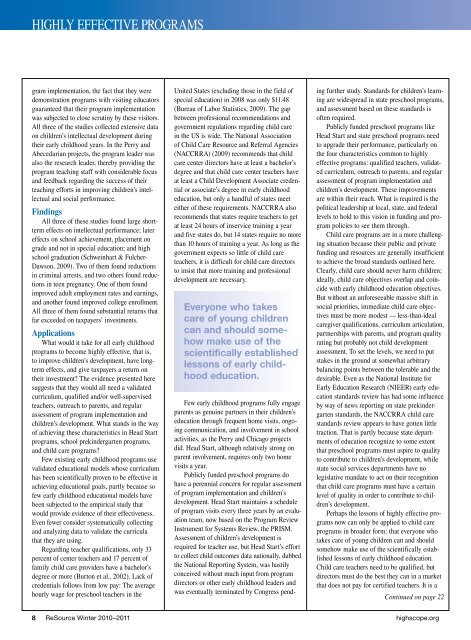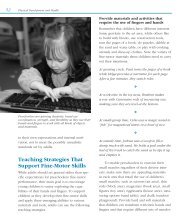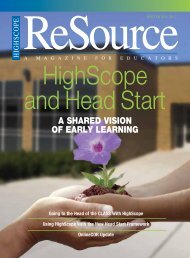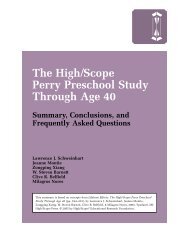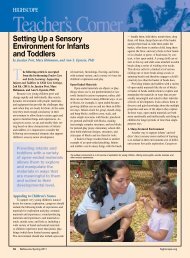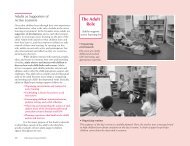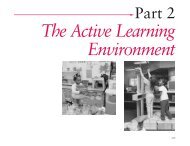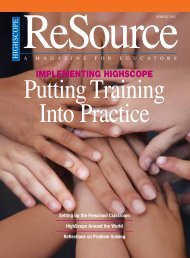DIVERSE AND INCLUSIVE CLASSROOM - High/Scope Educational ...
DIVERSE AND INCLUSIVE CLASSROOM - High/Scope Educational ...
DIVERSE AND INCLUSIVE CLASSROOM - High/Scope Educational ...
Create successful ePaper yourself
Turn your PDF publications into a flip-book with our unique Google optimized e-Paper software.
HIgHLY EffECTIvE PROgRAmS<br />
gram implementation, the fact that they were<br />
demonstration programs with visiting educators<br />
guaranteed that their program implementation<br />
was subjected to close scrutiny by these visitors.<br />
All three of the studies collected extensive data<br />
on children’s intellectual development during<br />
their early childhood years. In the Perry and<br />
Abecedarian projects, the program leader was<br />
also the research leader, thereby providing the<br />
program teaching staff with considerable focus<br />
and feedback regarding the success of their<br />
teaching efforts in improving children’s intellectual<br />
and social performance.<br />
Findings<br />
All three of these studies found large shortterm<br />
effects on intellectual performance; later<br />
effects on school achievement, placement on<br />
grade and not in special education; and high<br />
school graduation (Schweinhart & fulcher-<br />
Dawson, 2009). Two of them found reductions<br />
in criminal arrests, and two others found reductions<br />
in teen pregnancy. One of them found<br />
improved adult employment rates and earnings,<br />
and another found improved college enrollment.<br />
All three of them found substantial returns that<br />
far exceeded on taxpayers’ investments.<br />
Applications<br />
What would it take for all early childhood<br />
programs to become highly effective, that is,<br />
to improve children’s development, have longterm<br />
effects, and give taxpayers a return on<br />
their investment? The evidence presented here<br />
suggests that they would all need a validated<br />
curriculum, qualified and/or well-supervised<br />
teachers, outreach to parents, and regular<br />
assessment of program implementation and<br />
children’s development. What stands in the way<br />
of achieving these characteristics in Head Start<br />
programs, school prekindergarten programs,<br />
and child care programs?<br />
few existing early childhood programs use<br />
validated educational models whose curriculum<br />
has been scientifically proven to be effective in<br />
achieving educational goals, partly because so<br />
few early childhood educational models have<br />
been subjected to the empirical study that<br />
would provide evidence of their effectiveness.<br />
Even fewer consider systematically collecting<br />
and analyzing data to validate the curricula<br />
that they are using.<br />
Regarding teacher qualifications, only 33<br />
percent of center teachers and 17 percent of<br />
family child care providers have a bachelor’s<br />
degree or more (Burton et al., 2002). Lack of<br />
credentials follows from low pay: The average<br />
hourly wage for preschool teachers in the<br />
United States (excluding those in the field of<br />
special education) in 2008 was only $11.48<br />
(Bureau of Labor Statistics, 2009). The gap<br />
between professional recommendations and<br />
government regulations regarding child care<br />
in the US is wide. The national Association<br />
of Child Care Resource and Referral Agencies<br />
(nACCRRA) (2009) recommends that child<br />
care center directors have at least a bachelor’s<br />
degree and that child care center teachers have<br />
at least a Child Development Associate credential<br />
or associate’s degree in early childhood<br />
education, but only a handful of states meet<br />
either of these requirements. nACCRRA also<br />
recommends that states require teachers to get<br />
at least 24 hours of inservice training a year<br />
and five states do, but 14 states require no more<br />
than 10 hours of training a year. As long as the<br />
government expects so little of child care<br />
teachers, it is difficult for child care directors<br />
to insist that more training and professional<br />
development are necessary.<br />
Everyone who takes<br />
care of young children<br />
can and should somehow<br />
make use of the<br />
scientifically established<br />
lessons of early childhood<br />
education.<br />
few early childhood programs fully engage<br />
parents as genuine partners in their children’s<br />
education through frequent home visits, ongoing<br />
communication, and involvement in school<br />
activities, as the Perry and Chicago projects<br />
did. Head Start, although relatively strong on<br />
parent involvement, requires only two home<br />
visits a year.<br />
Publicly funded preschool programs do<br />
have a perennial concern for regular assessment<br />
of program implementation and children’s<br />
development. Head Start maintains a schedule<br />
of program visits every three years by an evaluation<br />
team, now based on the Program Review<br />
Instrument for Systems Review, the PRISm.<br />
Assessment of children’s development is<br />
required for teacher use, but Head Start’s effort<br />
to collect child outcomes data nationally, dubbed<br />
the national Reporting System, was hastily<br />
conceived without much input from program<br />
directors or other early childhood leaders and<br />
was eventually terminated by Congress pend-<br />
ing further study. Standards for children’s learning<br />
are widespread in state preschool programs,<br />
and assessment based on these standards is<br />
often required.<br />
Publicly funded preschool programs like<br />
Head Start and state preschool programs need<br />
to upgrade their performance, particularly on<br />
the four characteristics common to highly<br />
effective programs: qualified teachers, validated<br />
curriculum, outreach to parents, and regular<br />
assessment of program implementation and<br />
children’s development. These improvements<br />
are within their reach. What is required is the<br />
political leadership at local, state, and federal<br />
levels to hold to this vision in funding and program<br />
policies to see them through.<br />
Child care programs are in a more challenging<br />
situation because their public and private<br />
funding and resources are generally insufficient<br />
to achieve the broad standards outlined here.<br />
Clearly, child care should never harm children;<br />
ideally, child care objectives overlap and coincide<br />
with early childhood education objectives.<br />
But without an unforeseeable massive shift in<br />
social priorities, immediate child care objectives<br />
must be more modest — less-than-ideal<br />
caregiver qualifications, curriculum articulation,<br />
partnerships with parents, and program quality<br />
rating but probably not child development<br />
assessment. To set the levels, we need to put<br />
stakes in the ground at somewhat arbitrary<br />
balancing points between the tolerable and the<br />
desirable. Even as the national Institute for<br />
Early Education Research (nIEER) early education<br />
standards review has had some influence<br />
by way of news reporting on state prekindergarten<br />
standards, the nACCRRA child care<br />
standards review appears to have gotten little<br />
traction. That is partly because state departments<br />
of education recognize to some extent<br />
that preschool programs must aspire to quality<br />
to contribute to children’s development, while<br />
state social services departments have no<br />
legislative mandate to act on their recognition<br />
that child care programs must have a certain<br />
level of quality in order to contribute to children’s<br />
development.<br />
Perhaps the lessons of highly effective programs<br />
now can only be applied to child care<br />
programs in broader form: that everyone who<br />
takes care of young children can and should<br />
somehow make use of the scientifically established<br />
lessons of early childhood education.<br />
Child care teachers need to be qualified, but<br />
directors must do the best they can in a market<br />
that does not pay for certified teachers. It is a<br />
Continued on page 22<br />
8 ReSource Winter 2010–2011 highscope.org


